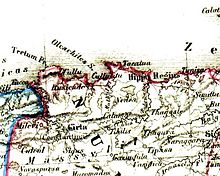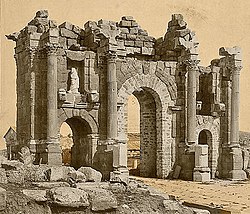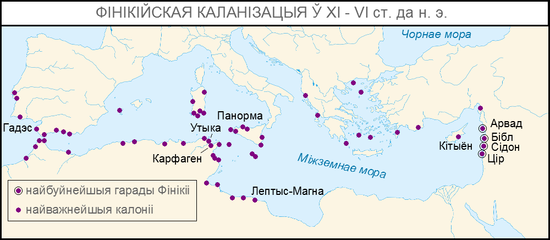Hippo Regius
 Hippo Regius ruins | |
 Shown within Algeria | |
| Location | Algeria |
|---|---|
| Region | Annaba Province |
| Coordinates | 36°53′0″N 7°45′7″E / 36.88333°N 7.75194°E / 36.88333; 7.75194Coordinates: 36°53′0″N 7°45′7″E / 36.88333°N 7.75194°E / 36.88333; 7.75194 |
Hippo Regius (also known as Hippo or Hippone) is the ancient name of the modern city of Annaba, in Algeria. Hippo Regius was a Phoenician, Berber, and Roman city in present-day Annaba Province, Algeria. It was the locus of several early Christian councils and home to the philosopher and theologian Augustine of Hippo.[1]
Contents
1 History
2 Ecclesiastical history
2.1 Council of Hippo
2.2 Titular episcopal see
3 See also
4 References
4.1 Citations
4.2 Bibliography
History

Hippo Regius on the map of Roman Numidia, Atlas Antiquus, H. Kiepert, 1869
Hippo is the latinization of .mw-parser-output .smallcaps{font-variant:small-caps}ʿpwn (Punic: 𐤏𐤐𐤅𐤍),[2][3] probably related to the word ûbôn, meaning "harbor".[4] The town was first settled by Phoenicians from Tyre around the 12th century BC. To distinguish it from other places of the same name, the Romans later referred to it as Hippo Regius ("the Royal Hippo") because it was one of the residences of the Numidian kings. Its nearby river was latinized as the Ubus and the bay to its east was known as Hippo Bay (Latin: Hipponensis Sinus).
A maritime city near the mouth of the river Ubus, it became a Roman colonia which prospered and became a major city in Roman Africa. It is perhaps most famous as the bishopric of Saint Augustine of Hippo in his later years. In AD 430, the Vandals advanced eastwards along the North African coast and laid siege to the walled city of Hippo Regius.[5] Inside, Saint Augustine and his priests prayed for relief from the invaders, knowing full well that the fall of the city would spell death or conversion to the Arian heresy for much of the Christian population. On 28 August 430, three months into the siege, St. Augustine (who was 75 years old) died,[6] perhaps from starvation or stress, as the wheat fields outside the city lay dormant and unharvested. After 14 months, hunger and the inevitable diseases were ravaging both the city inhabitants and the Vandals outside the city walls. The city fell to the Vandals and King Geiseric made it the first capital of the Vandal Kingdom until the capture of Carthage in 439.[7]
It was conquered by the Eastern Roman Empire in 534 and was kept under Roman rule until 698, when it fell to the Muslims; the Arabs rebuilt the town in the eighth century. The city's later history is treated under its modern (Arabic and colonial) names.
About three kilometres distant in the eleventh century, the Berber Zirids established the town of Beleb-el-Anab, which the Spaniards occupied for some years in the sixteenth century, as the French did later, in the reign of Louis XIV. France took this town again in 1832. It was renamed Bône or Bona, and became one of the government centres for the département of Constantine in Algeria. It had 37,000 inhabitants, of whom 10,800 were original inhabitants, consisting of 9,400 Muslims and 1400 naturalized Jews. 15,700 were French and 10,500 foreigners, including many Italians.
Ecclesiastical history
Hippo was an ancient bishopric, one of many suffragans in the former Roman province of Numidia, since French colonial rule a part of the residential see of Constantine. It contains some ancient ruins, a hospital built by the Little Sisters of the Poor and a fine basilica dedicated to St. Augustine. Under St. Augustine there were at least three monasteries in the diocese besides the episcopal monastery.
The diocese was established around 250 AD. Only these seven bishops of Hippo are known:
- Saint Theogenes [8] (256? – martyr 259?)
- Saint Leontius [8] (? – 303?)
- Fidentius (? – martyr ?304)
- Valerius (388? – 396), who ordained St. Augustine
- the "Doctor of Grace", Saint Augustine (354 – 28 August 430, coadjutor in 395, bishop in 396)
- Heraclius (coadjutor in 426, bishop in 430).
It was suppressed around 450 AD.
Council of Hippo
Three church councils were held at Hippo (393, 394, 426) and more synods – also in 397 (two sessions, June and September) and 401, all under Aurelius.
The synods of the Ancient (North) African church were held, with but few exceptions (e.g. Hippo, 393; Milevum, 402) at Carthage. We know from the letters of Saint Cyprian that, except in time of persecution, the African bishops met at least once a year, in the springtime, and sometimes again in the autumn. Six or seven synods, for instance, were held under St. Cyprian's presidency during the decade of his administration (249–258), and more than fifteen under Aurelius (391–429). The Synod of Hippo of 393 ordered a general meeting yearly, but this was found too onerous for the bishops, and in the Synod of Carthage (407) it was decided to hold a general synod only when necessary for the needs of all Africa, and it was to be held at a place most convenient for the purpose. Not all the bishops of the country were required to assist at the general synod. At the Synod of Hippo (393) it was ordered that "dignities" should be sent from each ecclesiastical province. Only one was required from Tripoli (in Libya), because of the poverty of the bishops of that province. At the Synod of Hippo (393), and again at the Synod of 397 at Carthage, a list of the books of Holy Scripture was drawn up, and these books (including some considered apocryphal by Protestants) are still regarded as the constituents of the Catholic canon.
Titular episcopal see
The Hippo(ne) diocese was nominally revived in 1400 as Catholic Latin titular bishopric of the (lowest) episcopal rank, for which no incumbent is recorded.
It ceased to exist on 23 September 1867, when the see was formally united with the Roman Catholic Diocese of Constantine.
See also
- Auzia
- Caesarea of Mauretania
- Cirta
- Chullu
- Mauretania Caesariensis
- Milevum
References
Citations
^ "A Berber, born in 354 at Thagaste (now Souk-Ahras) in Africa, he died as Bishop of Hippo (later Bone, now Annaba) in 430, while the Vandals were besieging the town.", Fernand Braudel, A history of civilizations (1963), Penguin Books, 1995, p. 335
^ Head & al. (1911), p. 886.
^ Ghaki (2015), p. 66.
^ Brown (2013), p. 326.
^ Collins 2000, p. 124
^ "CATHOLIC ENCYCLOPEDIA: St. Augustine of Hippo". www.newadvent.org. Retrieved 2018-02-01..mw-parser-output cite.citation{font-style:inherit}.mw-parser-output q{quotes:"""""""'""'"}.mw-parser-output code.cs1-code{color:inherit;background:inherit;border:inherit;padding:inherit}.mw-parser-output .cs1-lock-free a{background:url("//upload.wikimedia.org/wikipedia/commons/thumb/6/65/Lock-green.svg/9px-Lock-green.svg.png")no-repeat;background-position:right .1em center}.mw-parser-output .cs1-lock-limited a,.mw-parser-output .cs1-lock-registration a{background:url("//upload.wikimedia.org/wikipedia/commons/thumb/d/d6/Lock-gray-alt-2.svg/9px-Lock-gray-alt-2.svg.png")no-repeat;background-position:right .1em center}.mw-parser-output .cs1-lock-subscription a{background:url("//upload.wikimedia.org/wikipedia/commons/thumb/a/aa/Lock-red-alt-2.svg/9px-Lock-red-alt-2.svg.png")no-repeat;background-position:right .1em center}.mw-parser-output .cs1-subscription,.mw-parser-output .cs1-registration{color:#555}.mw-parser-output .cs1-subscription span,.mw-parser-output .cs1-registration span{border-bottom:1px dotted;cursor:help}.mw-parser-output .cs1-hidden-error{display:none;font-size:100%}.mw-parser-output .cs1-visible-error{font-size:100%}.mw-parser-output .cs1-subscription,.mw-parser-output .cs1-registration,.mw-parser-output .cs1-format{font-size:95%}.mw-parser-output .cs1-kern-left,.mw-parser-output .cs1-kern-wl-left{padding-left:0.2em}.mw-parser-output .cs1-kern-right,.mw-parser-output .cs1-kern-wl-right{padding-right:0.2em}
^ Andrew Merrills and Richard Miles, The Vandals (Blackwell Publishing, 2007), p. 60.
^ ab Tabbernee, 2014
Bibliography
Wikisource has the text of the 1913 Catholic Encyclopedia article Hippo Regius. |
| Wikimedia Commons has media related to Hippo Regius. |
 This article incorporates text from a publication now in the public domain: Herbermann, Charles, ed. (1913). "Hippo Regius". Catholic Encyclopedia. New York: Robert Appleton.
This article incorporates text from a publication now in the public domain: Herbermann, Charles, ed. (1913). "Hippo Regius". Catholic Encyclopedia. New York: Robert Appleton.
 This article incorporates text from a publication now in the public domain: Herbermann, Charles, ed. (1913). "African Synods". Catholic Encyclopedia. New York: Robert Appleton.
This article incorporates text from a publication now in the public domain: Herbermann, Charles, ed. (1913). "African Synods". Catholic Encyclopedia. New York: Robert Appleton.
- GigaCatholic, with residential episcopal incumbents biography links
Brown, Peter (2013), Through the Eye of a Needle: Wealth, the Fall of Rome, and the Making of Christianity in the West, 350–550 AD, Princeton: Princeton University Press, ISBN 1400844533.
Head, Barclay; et al. (1911), "Numidia", Historia Numorum (2nd ed.), Oxford: Clarendon Press, pp. 884–887.
Ghaki, Mansour (2015), "Toponymie et Onomastique Libyques: L'Apport de l'Écriture Punique/Néopunique" (PDF), La Lingua nella Vita e la Vita della Lingua: Itinerari e Percorsi degli Studi Berberi, Studi Africanistici: Quaderni di Studi Berberi e Libico-Berberi, No. 4, Naples: Unior, pp. 65–71, ISBN 978-88-6719-125-3, ISSN 2283-5636. (in French)
- Laffi, Umberto. Colonie e municipi nello Stato romano Ed. di Storia e Letteratura. Roma, 2007
ISBN 8884983509
- Mommsen, Theodore. The Provinces of the Roman Empire Section: Roman Africa. (Leipzig 1865; London 1866; London: Macmillan 1909; reprint New York 1996) Barnes & Noble. New York, 1996
- Smyth Vereker, Charles. Scenes in the Sunny South: Including the Atlas Mountains and the Oases of the Sahara in Algeria. Volume 2. Publisher Longmans, Green, and Company. University of Wisconsin. Madison,1871 ( Roman Hippo Regius )
- Tabbernee, William (ed.) (2014) Early Christianity in Contexts: An Exploration across Cultures and Continents Baker Academic (e-book [1] )

